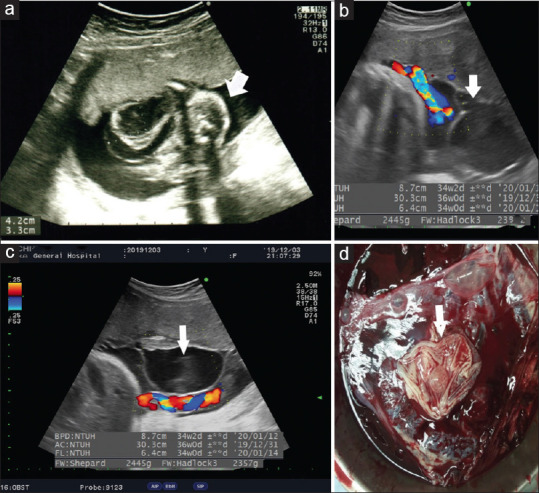A Placental Cyst Behind the Fetal Neck in the Mid-trimester Prenatal Sonography May Mimic a Fetal Cystic Hygroma.
IF 0.9
Q4 RADIOLOGY, NUCLEAR MEDICINE & MEDICAL IMAGING
引用次数: 0
Abstract
Subchorionic placental cysts occur in up to 5% of pregnancies, and the etiology is still controversial. Small single subchorionic placental cysts are of no clinical importance and no obstetrical management should be altered. However, a placental cyst beside the fetal neck in the mid-trimester prenatal sonography may mimic a fetal cystic hygroma that was poor prognosis. We reported a case of a placental cyst behind the fetal neck posteriorly in the mid-trimester prenatal sonography. A cyst-like lesion measured about 42 mm behind the fetal neck was detected by ultrasonography [Figure 1a]. This placental cyst was mistaken as a fetal cystic hygroma at first. However, further well examination confirmed the diagnosis of a placental cyst. At 34 gestational weeks of prenatal examination, an ultrasound revealed normal fetal growth with an intact fetal neural tube, and an independent placenta cyst was detected by transabdominal ultrasonography examination. The cyst was approximately 75 mm × 65 mm in diameter, and the intracystic echolucent area had an echodensity equivalent to that of amniotic fluid [Figure 1b and c]. Blood flow was not detected in the cystic structure on color Doppler ultrasound, and the Doppler examination of the umbilical artery revealed normal velocity and pulsatility. At 38 weeks of gestation, the woman came to our delivery room due to the onset of labor, then, a live mature female baby was delivered through vertex position through the vagina, weighting 3180 gm, body length 47 cm, with Apgar score of 9 and 9 at 1 and 5 min, respectively. A placenta cyst measured about 5cm was noted and revealed as subchorionic cyst with extravillous trophoblast cells found within the lining of the inside of the cystic wall [Figure 1d]. There were few studies showed that cases with large placental cysts with complex patterns inside the cyst. There may be an intracystic hematoma or intracystic hemorrhage.[1,2] On the other hand, because of extensive use in prenatal sonography, many fetal neck masses were noted before delivery. Therefore, A Placental Cyst Behind the Fetal Neck in the Mid‐trimester Prenatal Sonography May Mimic a Fetal Cystic Hygroma

妊娠中期胎儿颈部后的胎盘囊肿产前超声检查可能与胎儿囊性水肿相似。
本文章由计算机程序翻译,如有差异,请以英文原文为准。
求助全文
约1分钟内获得全文
求助全文
来源期刊

Journal of Medical Ultrasound
RADIOLOGY, NUCLEAR MEDICINE & MEDICAL IMAGING-
CiteScore
1.30
自引率
9.10%
发文量
90
审稿时长
10 weeks
期刊介绍:
The Journal of Medical Ultrasound is the peer-reviewed publication of the Asian Federation of Societies for Ultrasound in Medicine and Biology, and the Chinese Taipei Society of Ultrasound in Medicine. Its aim is to promote clinical and scientific research in ultrasonography, and to serve as a channel of communication among sonologists, sonographers, and medical ultrasound physicians in the Asia-Pacific region and wider international community. The Journal invites original contributions relating to the clinical and laboratory investigations and applications of ultrasonography.
 求助内容:
求助内容: 应助结果提醒方式:
应助结果提醒方式:


